NCERT Exemplar Class 11 Biology Solutions Chapter 13 Photosynthesis in Higher Plants
The NCERT Exemplar Class 11 Biology Solutions Chapter 13 Photosynthesis in Higher Plants discusses the process of photosynthesis. It explores the adaptations present in the plants that live in unusual environmental conditions. All the cycles that occur in the plants during the day and night have been broken down into simpler steps by our subject experts. Students can rely on the NCERT Exemplar to get a clear vision of the concepts and deepen their knowledge.
This Story also Contains
- Get Photosynthesis in Higher Plants Class 11 NCERT Exemplar (MCQs)
- Access the NCERT Exemplar Class 11 Biology Chapter 13- Very Short Answer Questions:
- Discover the NCERT Exemplar Class 11 Biology Chapter 13- Short Answer Questions
- Detailed Answers of Photosynthesis in Higher Plants Class 11 NCERT Exemplar
- Approach to Solve Questions of NCERT Exemplar Class 11 Biology Chapter 13
- Main topics of NCERT Exemplar Class 11 Biology Chapter 13
- Advantages of NCERT Exemplar Class 11 Biology Chapter 13 Solutions
- Important Question from Photosynthesis in Higher Plants Class 11 NCERT Exemplar
- NCERT Exemplar Class 11 Biology Solutions Chapter Wise
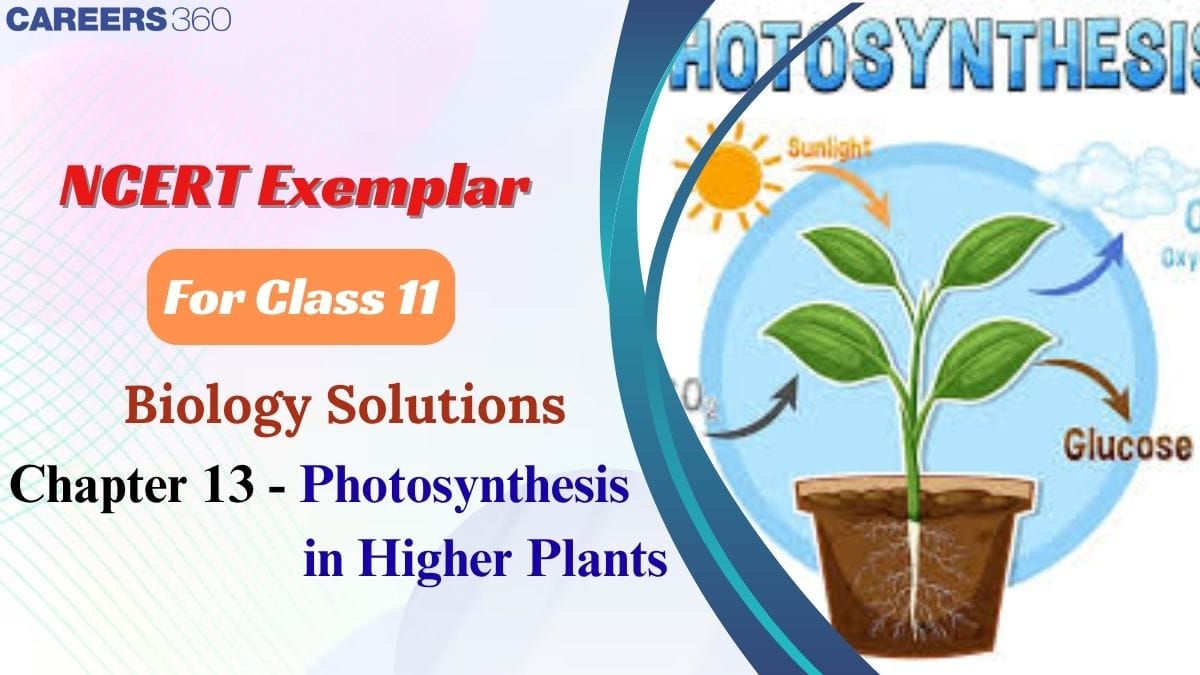
To know how photosynthesis takes place at different wavelengths, along with their graphs, students can use Photosynthesis in Higher Plants Class 11 NCERT Exemplar. Following this approach also allows students to score much better marks in the exams. The NCERT Exemplar Class 11 Biology Solutions Chapter 13 includes various types of questions, such as MCQs, short, and long answers. Regular practice of these will help them to understand every topic clearly.
Get Photosynthesis in Higher Plants Class 11 NCERT Exemplar (MCQs)
A variety of questions like MCQs, Short answers, and long answers, along with the required diagrams and graphs, are provided below to help you understand these complex topics easily and effectively, and gain more clarity on the doubts and solve them with ease.
Question:1
Which metal ion is a constituent of chlorophyll?
a. Copper
b. Magnesium
c. Iron
d. Zinc
Answer:
The correct answer is option (b), Magnesium
Explanation- A chlorophyll molecule has a cyclic structure with a ring, and it contains a magnesium atom in the center.
Question:2
Which pigment acts directly to convert light energy to chemical energy?
a. Carotenoid
b. Chlorophyll B
c. Chlorophyll A
d. Xanthophyll
Answer:
The correct answer is option (c), Chlorophyll A
Explanation – Chlorophyll A absorbs the maximum light and therefore directly converts light energy to chemical energy.
Question:3
Which range of wavelength (in nm) is called photosynthetically active radiation (PAR)?
a. 760 -10,000
b. 400 -700
c. 390 -430
d. 100 -390
Answer:
The correct answer is option (b), 400-700nm
Explanation: This range of visible light is called photosynthetically active radiation (PAR) because pigments like chlorophyll absorb light most effectively here, driving photosynthesis.
Question:4
Which light range is least effective in photosynthesis?
a. Red
b. Blue
c. Green
d. Violet
Answer:
The correct answer is option (c). Green
Explanation - The least effective light in photosynthesis is green light. As chlorophyll is present in leaves, the pigment responsible for photosynthesis reflects the green light rather than absorbing it.
Question:5
Chemosynthetic bacteria obtain energy from
a. Organic substances
b. Inorganic chemical
c. Sun
d. Infrared rays
Answer:
The correct answer is option (b). Inorganic chemical
Explanation - These bacteria obtain energy from the oxidation of inorganic chemicals to produce food.
Question:6
Energy required for ATP synthesis in PS II comes from
a. Electron gradient
b. Reduction of glucose
c. Oxidation of glucose
d. Proton gradient
Answer:
The correct answer is option (d), the Proton gradient
Explanation: In PS II, the splitting of water and electron transport creates a proton gradient across the thylakoid membrane, and this gradient drives ATP synthesis through ATP synthase.
Question:7
During the light reaction in photosynthesis, the following are formed.
a. ATP, hydrogen donor, and O2
b. ATP and sugar
c. ATP, hydrogen, and O2 donor
d. Hydrogen, O2, and sugar
Answer:
The correct answer is option (c), ATP, Hydrogen donor, and O2.
Explanation - During the light reaction of photosynthesis, ATP, hydrogen, and oxygen are formed. Hydrogen and oxygen are by-products of water splitting.
Question:8
Dark reaction in photosynthesis is called so because
a. It does not depend on light energy
b. It cannot occur during daylight
c. It occurs during daylight
d. It can occur in the dark
Answer:
The correct answer is option (a). It does not depend on light energy
Explanation - The "dark reaction" in photosynthesis is called so because it does not directly require light energy to occur, but instead, it uses the energy stored in ATP and NADPH produced during the light-dependent reactions.
Question:9
PEP is the primary CO2 acceptor in
a. C3 plants
b. C4 plants
c. C2 plants
d. Both C3 and C4 plants
Answer:
The correct answer is option (b). C4 plants
Explanation - PEP is the primary CO2 acceptor in C4 plants because it allows for carbon fixation, mainly in environments with low CO2 concentrations.
Question:10
The splitting of water is associated with
a. Lumen of the thylakoid
b. Photosystem I
c. Both photosystem I and II
d. Inner surface of thylakoid membrane
Answer:
The correct answer is option (d). Inner surface of the thylakoid membrane
Explanation- The splitting of water is associated with the inner thylakoid membrane because the water-splitting complex, part of Photosystem II (PSII), is located on that side, allowing the release of protons and electrons.
Question:11
The correct sequence of the flow of electrons in the light reaction is
a. PSI, ferredoxin, PSII
b. PSI, plastoquinone, cytochromes, PS II, ferredoxin
c. PS II, plastoquinone, cytochromes, PS I, ferredoxin
d. PS I, plastoquinone, cytochromes, PS I, ferredoxin
Answer:
The correct answer is option (c). PS II, plastoquinone, cytochromes, PS I, ferredoxin
Explanation: In the light reaction, electrons released from water first enter PS II, then pass through plastoquinone and the cytochrome complex, move to PS I, and finally reach ferredoxin, which helps in reducing NADP⁺ to NADPH.
Question:12
The enzyme that is found in a C3 plant is
a. ATP synthase
b. NADP reductase
c. PEP carboxylase
d. RuBP carboxylase
Answer:
The correct answer is option (d). RuBP carboxylase
Explanation - It is the main enzyme that catalyzes the first step of carbon fixation in the C3 plants.
Question:13
The reaction that is responsible for the primary fixation of CO2 is catalyzed by
a. PGA synthase
b. RuBP carboxylase and PEP carboxylase
c. RuBP carboxylase
d. PEP carboxylase
Answer:
The correct answer is option (b). RuBP carboxylase and PEP carboxylase
Explanation - PEP carboxylase catalyzes the reaction in C4 plants, and RuBP carboxylase in C3 plants.
Question:14
When CO2 is added to PEP, the first stable product synthesised is
a. Oxaloacetate
b. Pyruvate
c. Glyceraldehyde-3-phosphate
d. Phosphoglycerate
Answer:
The correct answer is option (a). Oxaloacetate
Explanation- Oxaloacetate is the first stable product, and it's a four-carbon compound.
Access the NCERT Exemplar Class 11 Biology Chapter 13- Very Short Answer Questions:
Question:1
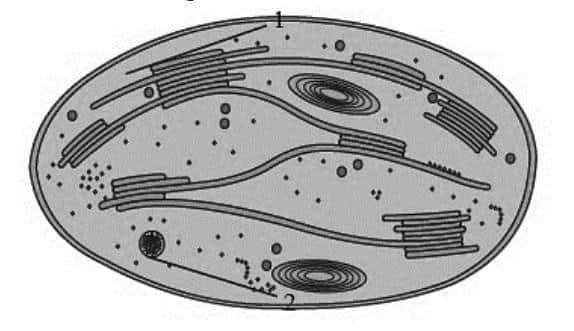
a. Is this structure present in animal cells or plant cells?
b. Can these be passed on to the progeny? How?
c. Name the metabolic processes taking place in the places marked (1) and (2).
Answer:
This structure is only found in plant cells.
Yes, chloroplasts, along with their DNA, can be passed on to progeny because chloroplasts to self-replicate, and this inheritance is generally maternal in most flowering plants.
(i) This is the site for the occurrence of the dark reaction.
(ii) Replication of the chloroplast occurs in the location mentioned as (ii).
Question:2
2H₂O → O₂ + 4H⁺ + 4e⁻
Based on the above equation, answer the following question:
a. Where does this reaction take place in plants?
b. What is the significance of this reaction?
Answer:
(a) It occurs in the thylakoid membrane of chloroplasts, mainly within the Photosystem II (PSII) complex.
(b) This reaction, also known as water splitting or photolysis, is an important step in the light-dependent reactions of photosynthesis because oxygen is released in this reaction as a byproduct of photosynthesis and is essential for respiration, and the electrons released from water are used to give energy to the electron transport chain.
Question:3
Answer:
Cyanobacteria and other photosynthetic bacteria, which do not have chloroplasts, conduct photosynthesis using photosynthetic pigments present in their cell membranes, specifically in internal membranes called thylakoids.
Question:4
A. Breakdown of proton gradient leads to release of ___________
B. NADP reductase enzyme is located on _______
Answer:
A. ATP molecules
B. The outer side of the thylakoid membrane
Question:5
Can girdling experiments be done in monocots? If yes, how? If not, why not?
Answer:
No girdling experiments can be performed on monocots because their vascular bundles are present throughout the stem, making it impossible to remove a continuous ring of bark (phloem) without disturbing the complete vascular system.
Question:6
3CO2 + 9ATP + 6NADPH + water → Glyceraldehyde 3-phosphate + 9ADP + 6NADP++8Pi
Analyse the above reaction and answer the following question
a. How many molecules of ATP & NADPH are required to fix one molecule of CO2?
b. Where in the chloroplast does this process occur?
Answer:
(a) 3 molecules of ATP and 2 molecules of NADPH are required to fix one molecule of carbon dioxide.
(b) This reaction occurs in the stroma of the chloroplast.
Question:7
Does moonlight support photosynthesis? Find out.
Answer:
No, moonlight does not support photosynthesis because it does not have the required energy to excite chlorophyll molecules, which is important for the light-dependent reactions of photosynthesis.
Question:8
Some of these terms/ chemicals are associated with the C4 cycle. Explain
a. Hatch Slack pathway
b. Calvin cycle
c. PEP carboxylase
d. Bundle sheath cells
Answer:
(a) Hatch–Slack pathway is the C4 pathway of photosynthesis in which CO2 is initially fixed into a 4-carbon compound (oxaloacetate) in mesophyll cells before being transferred to bundle sheath cells for the Calvin cycle.
(b) Calvin cycle, also called the C3 cycle, occurs in the stroma of chloroplasts where CO2 is fixed into a 3-carbon compound (3-PGA) using ATP and NADPH.
(c) PEP carboxylase is the enzyme in mesophyll cells of C4 plants that fixes CO2 to phosphoenolpyruvate (PEP), forming oxaloacetic acid, a 4-carbon compound.
(d) Bundle sheath cells are specialized cells surrounding the vascular bundles in C4 plants, where the Calvin cycle occurs, helping in efficient CO2 fixation and minimizing photorespiration.
Question:9
Answer:
NADP reductase enzyme is located on the outer side of the thylakoid membrane in chloroplasts. It plays an important role in maintaining the proton gradient by reducing NADP+ to NADPH, which takes protons from the stroma, thus contributing to the proton gradient.
Question:10
Answer:
The ATPase enzyme consists of two parts: F0 (integral membrane protein) and F1 (peripheral membrane protein). F0 is present in the inner region of the thylakoid membrane, while F1 lies in the outer region of the thylakoid, and conformational changes occur in the F1 portion. All the conformational changes occur in the F1 portion.
Question:11
Answer:
The products ATP and NADPH formed during the light reaction of photosynthesis drive the dark reaction. These products are used in the formation of glucose, a sugar that provides energy for the cell.
Question:12
What is the basis for designating C3 and C4 pathways of photosynthesis?
Answer:
The basis for the designations of C3 and C4 pathways in photosynthesis is based on the number of carbon atoms present in the first stable product. C3 pathways form a 3-carbon compound (3-PGA), while C4 pathways form a 4-carbon compound, which is oxaloacetate.
Discover the NCERT Exemplar Class 11 Biology Chapter 13- Short Answer Questions
Question:1
Answer:
Succulent plants grow in dry conditions. To these plants, they have to close down their stomata during the time to prevent water loss through transpiration, and also, the exchange of gases does not take place.
Thus, plants have developed a mechanism to fix CO2 during the night in the form of malic acid and release it during the day inside the photosynthetic cells.
Question:2
Answer:
Chlorophyll 'a' is the primary pigment for the light reaction, and the accessory pigments like chlorophyll b, carotenoids, and xanthophylls also help in photosynthesis by absorbing light of different wavelengths and transferring the energy to chlorophyll 'a', and can carry out the supporting process.
Question:3
Does the reaction of photosynthesis, called the ‘dark reaction,’ need light? Explain.
Answer:
Dark reactions of photosynthesis do not directly require light to occur. The dark reactions occur in the day. As a dark reaction does not require light, it doesn't mean it occurs at night; it only requires products of the light reaction, like ATP and NADPH. So, dark reactions indirectly need sunlight but can work without it as well.
Question:4
How are photosynthesis and respiration related to each other?
Answer:
Photosynthesis and respiration are interconnected as photosynthesis uses carbon dioxide and water to produce glucose and oxygen, while respiration uses glucose and oxygen, which is released as a by-product of photosynthesis, to produce carbon dioxide and water. It means both act as the reverse of each other.
Question:5
Answer:
A green plant kept in darkness, even with proper ventilation, cannot perform photosynthesis because sunlight is essential to carry out the process of photosynthesis. To maintain its growth or survival, the plant can be supplemented with sugars along with nutrients and water, but long-term growth is not possible without light.
Question:6
Answer:
No, photosynthetic organisms that occur at different ocean depths do not receive the same light, either qualitatively or quantitatively.
But deeper organisms also perform the process of photosynthesis very effectively, as these organisms are adapted to low-light conditions due to the presence of different pigments. These pigments absorb the light at available and different wavelengths.
Question:7
Answer:
Plants present in tropical rainforests, where the canopy is thick, despite receiving less amount of light to carry out photosynthesis, because they have adapted themselves to survive in low-light conditions, with changes like large leaves and high chlorophyll units. However, the process slowed down a little bit.
Question:8
What conditions enable RuBisCO to function as an oxygenase? Explain the ensuing process.
Answer:
RuBisCO is an enzyme that has a dual nature. It acts as a carboxylase when the CO2 concentration is high. But if O2 concentration increases and CO2 is low, especially at higher temperatures, it acts as an oxygenase. This leads to photorespiration, where RuBP reacts with oxygen, producing PGA and phosphoglycolate.
Question:9
Why does the rate of photosynthesis decrease at higher temperatures?
Answer:
The rate of photosynthesis decreases at higher temperatures because the enzymes involved in this process require the optimum conditions of temperature to work effectively, but as these conditions change, the rate of photosynthesis sis also affected.
Question:10
Explain how the light reaction of photosynthesis, ATP synthesis, is a chemiosmotic phenomenon.
Answer:
Chemiosmosis is the movement of ions across a semipermeable membrane, down their electrochemical gradient, to produce energy. During the light reaction of photosynthesis, ATP is synthesised, which is a chemiosmotic phenomenon because it involves the movement of protons across the thylakoid membrane, which creates a proton gradient that drives ATP synthesis by ATP synthase.
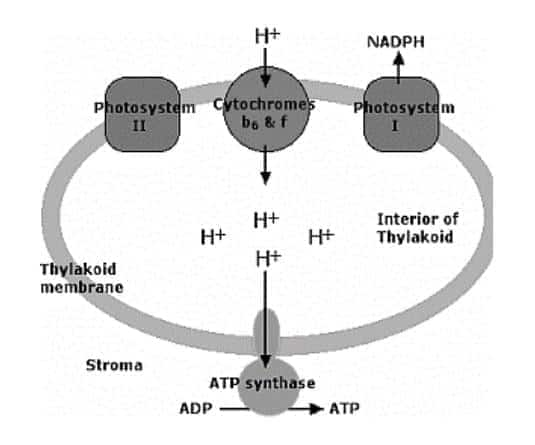
Question:11
Find out how Melvin Calvin worked out the complete biosynthetic pathway for the synthesis of sugar.
Answer:
Melvin Calvin and his associates discovered the Calvin cycle, which consists of various steps:-
They used 14C as a radioactive label to follow the path of photosynthetic carbon fixation. The labelled CO2 was fed to the algae for short periods.
The algal cells were killed immediately in boiling alcohol, and radioactivity in various compounds was separated by paper chromatography.
When algae were exposed to radioactive CO2 for less than five seconds, the first product that became radioactive was the phosphoglyceric acid.
This is how the Calvin cycle was discovered.
Question:12
Six turns of the Calvin cycle are required to generate one mole of glucose. Explain.
Answer:
Six turns of the Calvin cycle are needed to produce one molecule of glucose because each turn reduces one carbon dioxide molecule, two molecules of NADPH, and 2 molecules of ATP. Glucose is a six-carbon molecule, and thus, six CO2 molecules are required for the making of one mole of glucose.
Question:13
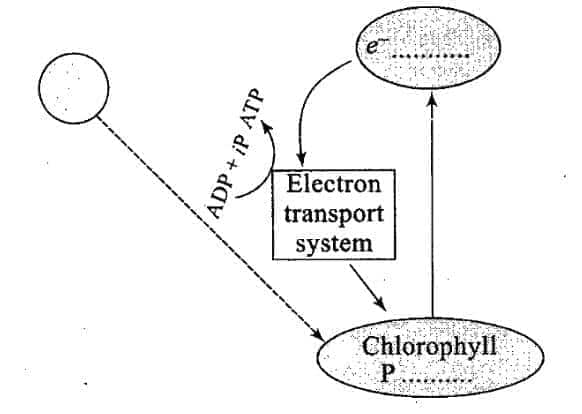
Answer:
The complete flow chart for cyclic photophosphorylation is given below:
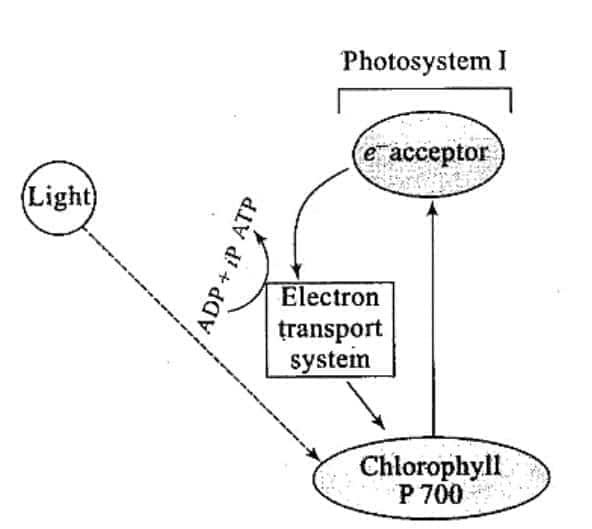
Question:14
Answer:
Kranz anatomy, a unique leaf structure, is found in C4 plants like maize and sugarcane. These plants are better adapted to dry, tropical conditions, where temperature and light intensities are very high. These plants are better adapted because Kranz anatomy helps them to minimize the process of photorespiration and maximize carbon fixation, which also leads to the easy manufacturing of glucose.
Question:15
A process is occurring throughout the day, in the’X’ organism. Cells participate in this process. During this process, ATP, CO2, and water are evolved. It is not a light-dependent process.
a. Name the process
b. Is it a catabolic or an anabolic process?
c. What could be the raw material of this process?
Answer:
a. The name of the process is respiration
b. The respiration process is a catabolic process.
c. The raw material used in this process is carbohydrates.
Question:16
Answer:
Tomatoes, Chillies, and Carrots are red due to the presence of a pigment called Lycopene. Lycopene is not a photosynthetic pigment; it's a carotenoid.
Question:17
Why do we believe chloroplasts and mitochondria to be semi-autonomous organelles?
Answer:
Mitochondria and chloroplasts are considered semi-autonomous organelles because they have their own DNA, ribosomes, and protein-synthesizing parts, allowing them to replicate independently and produce some of their own proteins, though they still depend on the cell for other functions.
Question 18:
Observe
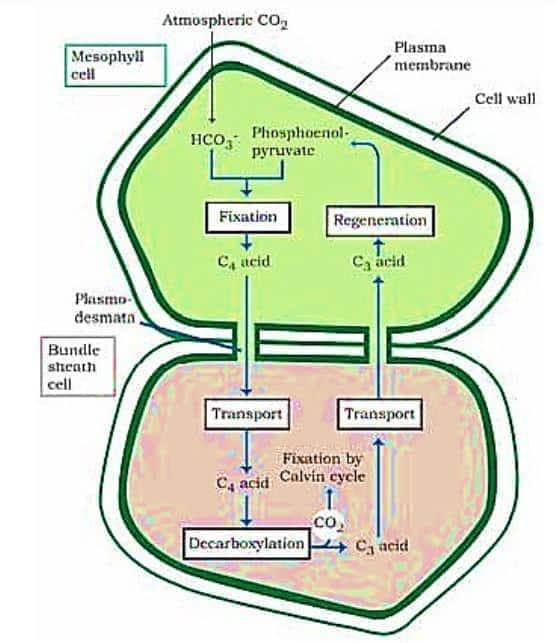
a. Which group of plants exhibits these two types of cells?
b. What is the first product of the C4 cycle?
c. Which enzyme is there in bundle sheath cells and mesophyll cells?
Answer:
a. Bundle sheath cells and mesophyll cells are found in C4 plants.
b. Oxaloacetic acid, a 4-carbon compound, is the first stable product.
c. PEP carboxylase is present in mesophyll cells, while RuBisCO is present in bundle sheath cells.
Question:19
A cyclic process occurs in a C3 plant, which is light-dependent and needs O2. This process does not produce energy; rather, it consumes energy.
a. Can you name the given process?
b. Is it essential for survival?
c. What are the end products of this process?
d. Where does it occur?
Answer:
a. The name of the process is photorespiration.
b. No, it is not important for survival.
c. The end products of this process are CO2 and water (H2O2 is formed as an intermediate in peroxisomes).
d. It occurs in chloroplasts, mitochondria, and peroxisomes.
Question:20
Suppose euphorbia and maize are grown in tropical areas.
a. Which one of them do you think will be able to survive under such conditions?
b. Which one of them is more efficient in terms of photosynthetic activity?
c. What differences do you think are there in their leaf anatomy?
Answer:
a. Euphorbia is a CAM plant. Therefore, it will be able to survive under such conditions.
b. Maize will be more efficient in photosynthesis because it is a C4 plant.
c. Kranz leaf anatomy is found in maize plants as they are C4 plants. In contrast, it is absent in Euphorbia, which uses the CAM pathway.
Detailed Answers of Photosynthesis in Higher Plants Class 11 NCERT Exemplar
Question:1
Answer:
No, it's not correct to say that photosynthesis occurs only in the leaves of a plant; while leaves are the main sites to carry out the process, any green part of a plant containing chlorophyll can also photosynthesise, including green stems, branches, and even some roots. For example:
Green Stems: Plants like cacti have thick and fleshy stems that function as leaves because they contain chlorophyll and chloroplasts for photosynthesis.
Green Branches: Just like stems, green branches can also do photosynthesis, especially in plants with limited leaf development.
In some plants, the sepals can also photosynthesise.
Question:2
The entire process of photosynthesis consists of a number of reactions. Where in the cell does each of these take place?
a. Synthesis of ATP and NADPH_____
b. Photolysis of water_______
c. Fixation of CO2 _______
d. Synthesis of sugar molecule________
e. Synthesis of starch________
Answer:
a. Thylakoid membrane
b. Thylakoid membrane (lumen side for water splitting)
c. Stroma of chloroplast
d. Stroma of chloroplast
e. Stroma of chloroplast (later stored in cytoplasm as starch grains)
Question:3
Answer:
The property of pigments, specifically chlorophyll, that initiates the process of photosynthesis is their ability to absorb photons of light and become excited, which allows them to transfer the energy, which is utilized to start the process.
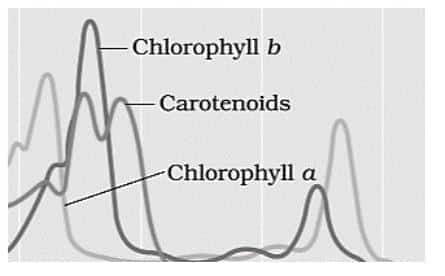
The process of photosynthesis is more efficient in red and blue light because these wavelengths are mostly absorbed by chlorophyll, thus increasing the rate of photosynthesis.
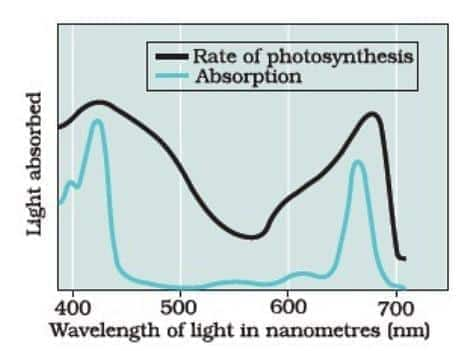
Question:4
Answer:
Action spectrum - It is the graph that shows the rate of photosynthesis at different wavelengths of light.
Absorption spectrum - A graph that shows the amount of light absorbed at different wavelengths of light.
When both the action and absorption spectra overlap, it indicates that the light which is absorbed is utilized for the process of photosynthesis. The peaks of these spectra indicate that chlorophyll a and b are the main photosynthetic pigments.
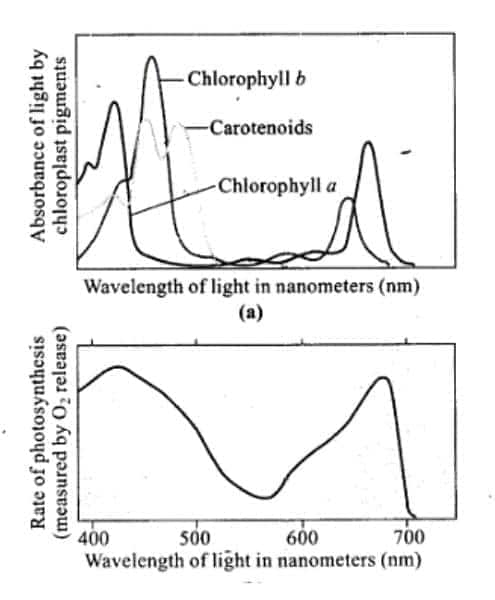
By looking at the above graph, it is very clear that the action spectrum shows maximum peaks of blue at 430–450 nm and red at 660–680 nm.
Question:5
Under what conditions are C4 plants superior to C3?
Answer:
C4 plants are considered to be superior to C3 plants. There are several reasons for this, which are provided below:
C4 plants can respond to higher temperatures and show a higher rate of photosynthesis, while C3 plants respond to a much lower value of optimum temperature range.
The C3 and C4 plants respond differently to CO2 concentrations. At low concentrations, C4 plants can carry out the process of photosynthesis, but C3 plants cannot do so.
C4 plants can perform photosynthesis even when their stomata are almost closed, but C3 plants can perform photosynthesis only when their stomata are open.
Question:6
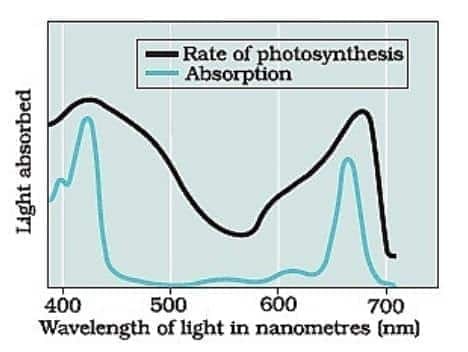
a. What does the action spectrum indicate? How can we plot an action spectrum? Explain with an example.
b. How can we derive an absorption spectrum for any substance?
Chlorophyll a is responsible for the light reaction of photosynthesis. Why do the action spectrum and absorption spectrum not overlap?
Answer:
(a) An action spectrum indicates the effectiveness of different wavelengths of light in the process, such as photosynthesis, by plotting the graph of the rate of photosynthesis against the wavelength of light.
To plot an action spectrum, firstly, we need to measure the amount of oxygen released during the process of photosynthesis on the y-axis under different wavelengths of light and then plot these rates against the corresponding wavelengths, which are present on the x-axis.
(b) An absorption spectrum can be plotted by passing a beam of light through a sample and measuring the amount of light that is absorbed at each wavelength. The obtained data is then plotted on a graph, with the given wavelength on the x-axis and how much light is absorbed on the y-axis.
(c) Action and absorption spectra don’t perfectly overlap because accessory pigments (chlorophyll b, carotenoids, xanthophylls) absorb additional light that contributes to the action spectrum.
Question:7
What are the important events and end products of the light reaction?
Answer:
The light reaction consists of various important events, which are given below:
1- Light Absorption: The pigments present in the leaves, such as chlorophyll and other accessory pigments, absorb the light at different wavelengths and then excite the electrons from lower energy levels to higher energy levels.
2-Water Splitting (Photolysis): Absorbed light energy is utilized to break down the molecule of water into oxygen, hydrogen ions, and electrons.
3- ATP Synthesis (Photophosphorylation): The proton gradient is used in the formation of ATP from ADP through synthetase.
4- NADPH formation- Electrons released from the electron transport chain are used to produce NADPH.
The end products of the light reaction are ATP, NADPH, and oxygen molecules.
Question:8
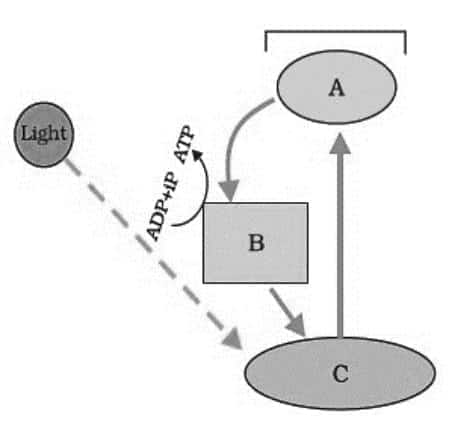
Answer:
The process of cyclic phosphorylation is depicted in this diagram.
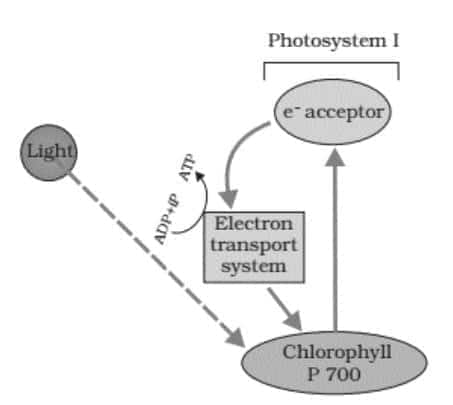
Question:9
Answer:
RuBisCO enzyme shows a dual nature as
Carboxylation: When there is a large concentration of carbon dioxide, RuBisCO binds with that and acts as a carboxylase.
Oxygenation: RuBisCO possesses an affinity for oxygen, depending on the concentration, and can work accordingly.
Therefore, it is often called RUBP Carboxylase-Oxygenase compound.
Importance of Photosynthesis:
Carbon Fixation: RuBisCO is the enzyme that fixes atmospheric CO2 into organic molecules, due to which it initiates the entire food chain.
Calvin Cycle: RuBisCO's carboxylation activity is the first step in the Calvin cycle, where CO2 is converted into sugar.
Photorespiration: This enzyme also plays a role in protecting plants from stress and in the recycling of carbon.
Question:10
Answer:
C4 plants show a different type of leaf structure where the vascular bundles are surrounded by cells with large chloroplasts, which helps to concentrate CO2, known as Kranz anatomy, which is not present in the C3 plants.
Advantages over C3 Plants:
Higher Photosynthetic Rates: C4 plants can maintain higher photosynthetic rates, especially in hot and dry conditions, due to their ability to avoid photorespiration, which C3 plants fail to do.
Water Conservation: By minimizing photorespiration, C4 plants can conserve water more effectively where less water is present, as they can close their stomata, reducing photosynthetic efficiency.
Adaptation to Hot Environments: The Kranz anatomy and the C4 pathway allow C4 plants to survive in environments where C3 plants struggle in hot, arid regions.
Question:11
In the C3 pathway, the key enzyme for CO2 fixation is RuBisCO, which is known as RUBP Carboxylase Oxygenase, while in the C4 pathway, it's PEP carboxylase. RuBisCO fixes CO2 to RuBP, and PEP carboxylase fixes CO2 to PEP.
In C3 plants, RuBisCO (Ribulose-1,5-bisphosphate carboxylase-oxygenase) is the main enzyme that is responsible for carbon fixation.
PEP carboxylase is the key enzyme in the C4 pathway. It combines with carbon dioxide to result in the formation of a 4-carbon compound called OAA or oxaloacetic acid. This is further converted into carbon dioxide.
Question:12
Why is RuBisCO enzyme the most abundant enzyme in the world?
Answer:
RuBisCO is the most abundant enzyme on Earth because it's the main enzyme responsible for carbon fixation during photosynthesis. The enzyme is present in all plants performing photosynthesis, which is an important process essential for plant growth.
Also, check the NCERT Books and NCERT Syllabus here.
Approach to Solve Questions of NCERT Exemplar Class 11 Biology Chapter 13
Solving questions is important because it helps students break down big topics like photosynthesis into smaller parts. It also guides them to focus on diagrams, key terms, and stepwise processes.
Read the NCERT and Exemplar solutions to understand each step of photosynthesis, like light and dark reactions.
Practice drawing diagrams of chloroplast structure, light reactions, and the Calvin cycle.
Memorise key terms like Photosystem I and II, RuBisCO, and ATP/NADPH formation.
Solve questions given in NCERT Exemplar Class 11 Biology Solutions Chapter 13, focusing on application-based and reasoning questions.
Revise the differences between C3, C4, and CAM pathways, and understand photorespiration.
Also, read the NCERT Solution subject-wise
Main topics of NCERT Exemplar Class 11 Biology Chapter 13
This chapter explains how photosynthesis takes place in higher plants and what steps and reactions are involved throughout the process.
Structure of Chloroplast
Light and Dark Reactions
Cyclic and Non‑cyclic Photophosphorylation
Calvin Cycle (C3 Pathway)
C4 and CAM Pathways
Factors Affecting Photosynthesis (light intensity, CO₂, temperature)
NCERT Exemplar Class 11 Solutions for Other Subjects
Advantages of NCERT Exemplar Class 11 Biology Chapter 13 Solutions
The Photosynthesis in Higher Plants chapter explains how plants convert light energy into chemical energy through different steps and pathways. Solving exemplar problems makes students understand all the concepts clearly and easily without any confusion.
- NCERT Exemplar Class 11 Biology Chapter 13 Solutions cover questions related to the light reaction, Calvin cycle, factors affecting photosynthesis, etc.
- The exemplar problems improve the ability to answer the numerical and graph-based questions related to the rate of photosynthesis.
- Students will understand how to write answers in the exam in the correct format, along with accuracy.
- The solutions provide a detailed explanation of the pathways along with the well-labeled diagrams.
- Solving different questions such as MCQs, short, and long, allow students to improve problem-solving skills and boosts confidence.
Important Question from Photosynthesis in Higher Plants Class 11 NCERT Exemplar
This chapter is important because NEET often asks questions about Photosynthesis, focusing on how plants make food. The question given below helps the students to understand the key concepts of this chapter. For more such questions, students can refer to the NCERT Exemplar Class 11 Biology Solutions Chapter 13.
Question 1. In which part of the chloroplast does the light reaction of photosynthesis take place?
Option 1. Stroma
Option 2. Grana
Option 3. Outer membrane
Option 4. Inner membrane
Answer:
The light reaction of photosynthesis takes place in the grana of the chloroplast. Grana are stacks of thylakoid membranes where chlorophyll and other pigments capture light energy. The captured light energy is used for the process of photolysis, which releases oxygen and generates molecules of ATP and NADPH. These molecules are important to carry out the process of the light reaction.
Hence, the correct answer is option (2), Grana.
Question 2. The reaction that is responsible for the primary fixation of CO2 is catalysed by
Option 1. PGA synthase
Option 2. RuBP carboxylase and PEP carboxylase
Option 3. RuBP carboxylase
Option 4. PEP carboxylase
Answer :
PEP carboxylase in C4 plants is highly efficient in fixing CO2, even at low concentrations, by forming oxaloacetate in mesophyll cells. In contrast, RuBP carboxylase (Rubisco) in C3 plants fixes CO2 directly during the Calvin cycle but is less efficient due to its oxygenase activity, leading to photorespiration. This differentiation allows C4 plants to thrive in hot, dry environments by minimising photorespiration.
Hence, the correct answer is option (2), RuBP carboxylase and PEP carboxylase.
Question 3. The correct sequence of the flow of electrons in the light reaction is
Option 1. PSI, ferredoxin, PSII
Option 2. PSI, plastoquinone, cytochromes, PS II, ferredoxin
Option 3. PS II, plastoquinone, cytochromes, PS I, ferredoxin
Option 4. PS I, plastoquinone, cytochromes, PS I, ferredoxin
Answer :
In the light reaction, the proper order of electron flow is Ferredoxin, PSI, PSII, Plastoquinone, and Cytochromes.
Thylakoids are subject to light-dependent responses. They include:
Water photolysis: Water splitting into H2 and O2
Assimilation power production: ATP and NADPH
The P680 photo center of photosystem II absorbs the electron generated during the photolysis of water.
Hence, the correct answer is option (3) PS II, plastoquinone, cytochromes, PS I, ferredoxin.
Must Read NCERT Notes subject-wise
NCERT Exemplar Class 11 Biology Solutions Chapter Wise
The chapter-wise links are given below:
Frequently Asked Questions (FAQs)
Yes, the Calvin cycle functions in C3 plants for carbon fixation. It occurs in the chloroplast stroma, where RuBisCO incorporates CO₂ into a 3-carbon compound (3-PGA), later converted into glucose using ATP and NADPH. However, C3 plants face photorespiration in hot, dry conditions, reducing efficiency.
RuBisCO is a key enzyme in the Calvin cycle, responsible for fixing carbon dioxide by catalyzing its attachment to a 5-carbon sugar called ribulose bisphosphate (RuBP). This forms an unstable 6-carbon compound that quickly breaks down into two molecules of 3-phosphoglycerate (3-PGA).
Chlorophyll plays a crucial role in photosynthesis by absorbing light energy, primarily in the blue and red wavelengths, and converting it into chemical energy. It is the pigment found in chloroplasts that captures sunlight and helps power the light-dependent reactions. Questions based on the concept of chlorophyll are included in the NCERT Exemplar Class 11 Biology Solutions Chapter 13 Photosynthesis in Higher Plants.
Photosynthesis in higher plants is the process by which they produce food using sunlight, carbon dioxide, and water. It occurs in the chloroplasts, where chlorophyll absorbs sunlight. The process is divided into 2 steps, which are explained in the NCERT Exemplar Class 11 Biology Solutions Chapter 13 Photosynthesis in Higher Plants.
In photosynthesis, the electron transport chain transfers excited electrons from chlorophyll through proteins in the thylakoid membrane. This process generates a proton gradient, which drives ATP production via ATP synthase. Electrons are re-energized in Photosystem I to form NADPH. Both ATP and NADPH are then used in the Calvin cycle to produce glucose.
CAM (Crassulacean Acid Metabolism) plants perform photosynthesis by adapting to hot, dry environments. They open their stomata at night to take in carbon dioxide, which is stored as malic acid in vacuoles. During the day, when stomata are closed to prevent water loss, the stored CO₂ is released and used in the Calvin cycle for glucose production. This adaptation allows CAM plants to minimize water loss while still carrying out photosynthesis.
The light reaction of photosynthesis occurs in the thylakoid membranes, where chlorophyll absorbs light energy. This excites electrons in Photosystem II, which move through an electron transport chain, leading to ATP production. Water is split to replace lost electrons, releasing oxygen. The electrons reach Photosystem I, are re-energized, and help form NADPH. ATP and NADPH produced in this process are then used in the Calvin cycle for glucose synthesis.
Popular Questions
Courses After 12th
Applications for Admissions are open.
As per latest syllabus. Physics formulas, equations, & laws of class 11 & 12th chapters
JEE Main Important Chemistry formulas
Get nowAs per latest syllabus. Chemistry formulas, equations, & laws of class 11 & 12th chapters
JEE Main high scoring chapters and topics
Get nowAs per latest 2024 syllabus. Study 40% syllabus and score upto 100% marks in JEE
JEE Main Important Mathematics Formulas
Get nowAs per latest syllabus. Maths formulas, equations, & theorems of class 11 & 12th chapters
